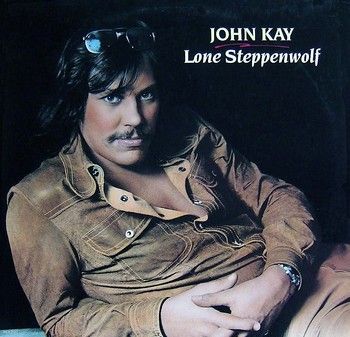
Contains 10 of the best selections from John Kay’s solo albums, “Forgotten Songs and Unsung Heroes” (1972) and “My Sportin’ Life” (1973). It contains both his well-known version of Hank Snow's "I'm Movin' On" from 1972 and his great version of Mentor Williams' (brother of Paul Williams) "Drift Away" from early 1973 (originally recorded by John Henry Kurtz on his 1972 album Reunion) but recorded by John Kay before Dobie Gray's hit version was released in late 1973. John Kay has this to say about "My Sportin’ Life" - "With the exception of “Sing With The Children”, the rest of the songs were recorded by studio musicians and myself. Mike Utley, keyboards, Russ Kunkel, drums, Danny Kortchmar, guitar and Lee Sklar, bass. With hindsight, I feel the album was perhaps, a little over produced and at times had a pop sound. Nevertheless this is still one of my favorite albums to this day. I’m particularly fond of my version of “Drift Away” as well as “My Sportin’ Life” “Nobody Lives Here Anymore” and “Dance To My Song”. Two other favorites of mine are “Sing With The Children” (double slide guitar work between Kent Henry and myself) and “Easy Evil” which has a great feel and Gloria Jones’ sexy harmony. People still comment on that song to this day"."Lone Steppenwolf" is a really good album from John Kay in the country rock/folk style with some blues. Check out John's "My Sportin' Life" album on this blog which contains a rare cover of Donald Fagen & Walter Becker's "Giles of the River" [All tracks @ 320 Kbps: File size = 95.8 Mb]
TRACKS / COMPOSERS
1. EASY EVIL (Alan O' Day) 3:34
2. WALKIN' BLUES (Arranged by Robert Johnson) 2:44
3. MANY A MILE (Patrick Sky) 4:29
4. DRIFT AWAY (Mentor Williams) 4:07
5. SING WITH THE CHILDREN (Ron Davies) 6:33
6. MY SPORTIN' LIFE (John Kay) 5:15
7. YOU WIN AGAIN (Hank Williams) 4:02
8. I'M MOVIN' ON (Hank Snow) 3:07
9. NOBODY LIVES HERE ANYMORE (John Kay) 3:57
10. SOMEBODY (John Kay) 4:07
MUSICIANS
John Kay - Guitar, 12 String Guitar, Electric Guitar, Bottleneck Guitar, Dulcimer, Harp, Vocals
Danny Kortchmar, Kent Henry - Guitar
George Biondo, Leland Sklar, Bill Cooper - Bass
Hugh Sullivan, Daryl Dragon, Larry Knechtel, Alan O'Day - Keyboards
Richard Podolor - Keyboards, Mandolin, Guitar, OrganTambourine, Jawbone
Mike Utley - Piano
Whitey Glan, Russ Kunkel - Drums
Venetta Fields, Sherrie Matthews, Gloria Jones, Marsha Temmer, Alexandra Sliwin, Joan Sliwin, Stan Farber, Gene Morford - Vocals
BIO
Steppenwolf leader/founder John Kay is perhaps the most overlooked early contributor to the musical style that would become heavy metal and hard rock. Kay was the first rocker to use the phrase heavy metal in a song, in one of metal's first great anthems: Steppenwolf's 1968 classic "Born to Be Wild." Born Joachim Fritz Krauledat on April 12, 1944, in the section of Germany that was once known as East Prussia, it was the American rock & roll that he heard on U.S. Armed Forces radio after his family moved to East Germany that fueled his interest in music. After relocating to Toronto, Canada, in 1958, Kay became even more transfixed by rock & roll -- leading to Kay picking up the guitar, writing songs, and playing in local bands. In the '60s, Kay founded the Sparrow, a rock outfit who played both Canada and the U.S., but received little attention. The group had fallen apart by 1967, but with a new, harder-edged style of rock beginning to conquer the charts and airwaves (Cream, Jimi Hendrix, and the Yardbirds), Kay decided to pursue this direction with his next band, Steppenwolf (titled after Hermann Hesse's novel of the same name). After moving to Los Angeles, the fledgling band was signed to Dunhill and recorded their self-titled debut, issued in 1968. The album became a sizeable hit, as "Born to Be Wild" was unleashed on an unsuspecting record-buying public, becoming one of rock's most instantly identifiable and enduring hits of all time. After the track was used in the 1969 cult classic movie Easy Rider, it subsequently appeared in countless other movies and TV commercials over the years and was covered by numerous other bands (Blue Oyster Cult, Slade, Crowded House, and the Cult). Steppenwolf continued to crank out hit albums (1968's The Second, 1969's At Your Birthday Party, and 1969's Monster), singles ("Magic Carpet Ride," "Rock Me"), and tours on a regular basis, with Kay being the only constant member among a revolving door of other musicians. By 1972, Kay decided to end the group, issuing his first solo albums around the same time: Forgotten Songs & Unsung Heroes and My Sportin' Life. Steppenwolf's retirement didn't last for long, however, as Kay alternated between the band and his solo career throughout the '70s, '80s, and '90s. He even took a few former members of the band to court when they, too, began touring behind the name Steppenwolf. In 1994, Kay penned an autobiography, Magic Carpet Ride, and four years later, Steppenwolf and Kay were the subject of an interesting Behind the Music episode for VH1. © Greg Prato © 2011 Rovi Corporation. All Rights Reserved http://www.allmusic.com/artist/john-kay-p13383/biography





5 comments:
LINK
You may need a password. Please use aoofc
Thank you..2ndd
Hope you are enjoying California Mr Fingal. I have never set foot on that continent, and don't expect to anytime soon. That is not because of a lack of intent, rather a lack of Brass in Pocket. Anyhoo, thanks for posting this. I will enjoy it...Ratso
I've always liked the solo work from Kay that I've heard. Thanks for the chance to hear this one.
Hi. Great artist and v.much appreciated. Thanks
Hi,ratso! Just back from Cal. "I wish they all could be California girls"!Beautiful part of the world and worth a visit if you can. Thanks as usual, and TTU later..P
Post a Comment